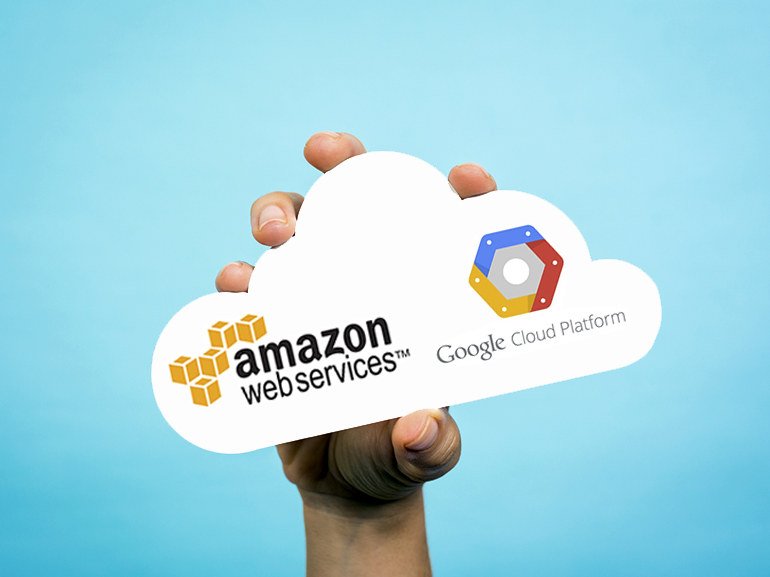Are Amazon and Google the hybrid cloud advocates they claim to be?


Many enterprises remain in denial about the inevitability of public cloud computing, insisting on keeping workloads in private data centers, but Amazon's argument is clear: All your workloads will belong to the public cloud. Eventually. Google, too, has long been keen on accelerating workloads away from private data centers and into its cloud, arguing that "public [is the] default."
Oh, sure, at last year's AWS re:Invent Amazon's cloud chief, Andy Jassy, extended an olive branch to server-hugging enterprises, acknowledging that some workloads will "definitely be running in hybrid mode for a while," whether due to regulatory requirements or the difficulty of migration. Not to be outdone, Google's Miles Ward told me that Google "doesn't insist on public cloud," because "reality has interesting edge cases" and "a single vendor can't predict [or] provide everything."
Despite this newfound respect for hybrid cloud at both AWS and Google, the reality is that both companies stand to make a fortune as enterprises move workloads to the public cloud. Yes, they may go through the motions of supporting hybrid use cases, but both companies have public cloud in their DNA.
The question is, should you? Do their arguments stand up to scrutiny?
The hybrid sop to legacy enterprise IT
A recent Rightscale survey found that 71 percent of enterprises rely on a mix of private and public cloud resources. This isn't surprising. Despite the fact that AWS banked $7.3 billion in cloud revenue, with Microsoft coming in second with $1.5 billion, most servers remain earthbound in private data centers.
Sometimes IT convinces itself that it's doing cloud by calling a private data center 'private cloud', but a "model that requires companies to invest heavily in virtualization and maintaining their own data centers is not a 'real cloud' model," as Jassy declared years ago. Not only is private cloud 'faux cloud' but, as cloud pundit David Linthicum stresses, "Google and AWS don't have private clouds, for good reason: Nobody wants them!"
Hybrid, however, is supposed to be different. Hybrid clouds are meant to give enterprises the freedom and convenience of public cloud while offering the safety blanket of keeping 'mission-critical workloads' protected under lock and key within private data centers. (Just don't probe too far or you'll discover that most security breaches have hit private data centers, not public clouds.)
Still, concerns persist, so both Amazon and Google have started making friendly overtures toward hybrid clouds.
Hence, at AWS re:Invent 2015, Jassy first said, "We've had a strong belief...that over the fullness of time -- ten to twenty years -- relatively few companies will have their own data centers and those that do will have much smaller footprints." He then acknowledged that due to regulatory requirements or suitability of legacy workloads, some applications will "definitely be running in hybrid mode for a while."
SEE: Google Cloud Platform breaks through with big enterprises, signs up Disney and others
Ditto Google. A Google cloud representative told me that he believes 75 percent of total compute workloads can go to the public cloud. However, he also stressed that moving 90 percent or more workloads to public clouds "isn't likely even ten to fifteen years out." Plus, he continued, "that 25 percent [of non-public workloads] have some real utility, and we need to integrate" to support them.
But sometimes actions speak louder than words.
Migration made easy
This is particularly true of AWS. In the same conference that Amazon acknowledged a hybrid reality for some of its customers, it also put GE on stage. GE plans to move 90 percent of its workloads to AWS. And virtually every product announcement revolved around migration from private to public cloud, and not some mongrel hybrid state.
As cloud luminary Bernard Golden summarized, "While AWS has heretofore primarily hosted greenfield applications, leaving legacy applications to be treated as cash cows by the vendors whose technology is embedded in them, now it's directing its efforts at a takeaway game." Indeed, Amazon's database migration service is already seeing broad adoption, with AWS chief data scientist Matt Wood touting that 1,000-plus databases have already been migrated.
Google has been a bit more diplomatic, talking nicely about hybrid clouds and insisting that "Lock-in is not an issue using Google Cloud Platform." But then, what else can it say? Although the company wants enterprise workloads running fully on its cloud, as AWS does, Google has a long way to go to catch up with AWS and Microsoft in cloud revenue, not to mention IBM and Oracle.
Regardless, however much AWS and Google may talk about hybrid cloud, they make their money as more workloads run on their public clouds. Are they therefore too conflicted to be trusted?
SEE: How Google will beat Amazon's cloud
Running in the cloud
Let's go back to Jassy. Years ago he proclaimed, "Organizations that have private cloud systems [or private data centers] will have missed out on all the advantages and benefits of going into the cloud." While cost is a consideration, business agility is the primary driver of cloud computing, and that's not easily achieved in private clouds (or hybrid clouds, which trade off agility for perceived security).
This is reflected in something Wood once told me. Although he was discussing the importance of elastic infrastructure for data science, the same principle applies to IT, generally:
"Those that go out and buy expensive infrastructure find that the problem scope and domain shift really quickly. By the time they get around to answering the original question, the business has moved on. You need an environment that is flexible and allows you to quickly respond to changing big data requirements. Your resource mix is continually evolving -- if you buy infrastructure, it's almost immediately irrelevant to your business because it's frozen in time. It's solving a problem you may not have or care about any more."
Sure, Amazon has a financial interest in selling this vision. But it's also selling the public cloud vision because it's the only real way to get the convenience and agility of cloud. The minute you're babysitting a server, you're stuck.
Is it therefore surprising, quoting Gartner analyst Lydia Leong, that "AWS sees hybrid as being able to run enterprise-class workloads in AWS and have them comfortably co-exist and interoperate with on-premises workloads -- until the enterprise gets smart and moves all of it to AWS"? Of course not. Enterprises may believe hybrid is a haven from performance and security nightmares, but Amazon knows that it's just a temporary stopping point on the way to full public cloud.
Yes, enterprises will keep running some percentage of their workloads on their own infrastructure for a variety of reasons. As my Google source told me, maybe it's 10 to 25 percent.
That leaves 75 to 90 percent of enterprise workloads up for public cloud grabs. AWS, at least at current pace, will claim most of those. But ZDNet's Larry Dignan is correct to argue that "Every enterprise will have multiple cloud infrastructure providers" as they use competition to keep costs down.
That's the real cloud battle: not hybrid versus public, but rather which public cloud will earn the most loyalty (and hence, cash). For now, AWS and Google see that it's in their interest to placate cloud-wary enterprises by waving a hybrid banner, but the real value of cloud computing comes with capitulation to public-cloud computing.
Also see:
- AWS makes Database Migration Service available to all customers
- AWS at 10: A look at how Amazon revamped the enterprise cloud computing pecking order
- Google Cloud Platform adds regions, aims to close global cloud computing gap
- Apple's hybrid cloud plan: Google, AWS, Microsoft Azure like most companies